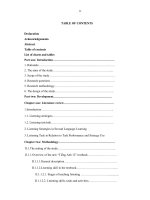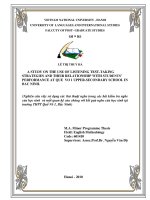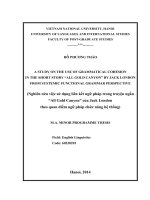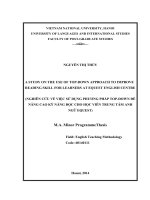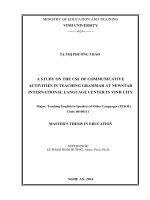A study on the use of listening test-taking strategies and their relationship with students' performance at Que Vo I Upper Secondary School in Bacninh
Bạn đang xem bản rút gọn của tài liệu. Xem và tải ngay bản đầy đủ của tài liệu tại đây (308.61 KB, 12 trang )
A study on the use of listening test-taking
strategies and their relationship with students'
performance at Que Vo I Upper Secondary
School in Bacninh
Lê Thị Thúy Hà
Trường Đại học Ngoại Ngữ
Luận văn ThS. Chuyên ngành: English Linguistics; Mã số: 60 22 15
Người hướng dẫn: Prof.Dr. Nguyễn Văn Độ
Năm bảo vệ: 2010
Abstract: This study examines 165 (in 4 groups) Que Vo I upper-secondary school students’
test-taking strategies and their relationship with listening performance. It further looks into
how students adjust their strategies under different task conditions. The participants will
complete a three-phase (before/during/after) test-taking questionnaire and will be given a
listening test comprising tasks. After each subtest, students will report the strategies used
based on a strategy list, and further “wrote in” their own strategies. The results show that all
students favor some strategies, regardless of their listening proficiency. The difference
between high- and low-level students is not in the number of strategies used but in the
preferential order and frequency of use. Students’ listening performance had a strong
correlation with the strategy used before the test-taking phase. Based on students’ reported
strategies it was found that students were able to adjust their strategy use according to the
change in task conditions, the same strategy may be used in different ways and for different
purposes by different levels of students, some strategies are interrelated and are used
concurrently, and test-taking strategy involves multiple dimensions, making it difficult to
tease out one factor from another.
Keywords: Tiếng Anh; Thủ thuật nghe; Bài kiểm tra; Kỹ năng nghe.
iv
Content:
TABLE OF CONTENTS
Declaration
Acknowledgements
Abstract
Table of contents
List of charts and tables
Part one: Introduction………………………………………………………
1. Rationale……………………………………………………………………
2. The aims of the study……………………………………………………
3. Scope of the study………………………………………………………….
4. Research questions…………………………………………………………
5. Research methodology……………………………………………………
6. The design of the study……………………………………………………
Part two: Development……………………………………………………
Chapter one: Literature review……………………………………………
1.Introduction………………………………………………………………
1.1. Listening strategies……………………………………………………
1.2. Listening test/task……………………………………………………….
2. Listening Strategies in Second Language Learning
3. Listening Task in Relation to Task Performance and Strategy Use
Chapter two: Methodology………………………………………………….
II.1.The setting of the study…………………………………………………
II.1.1.Overview of the new “Tiếng Anh 12” textbook…………………………
II.1.1.1.General description………………………………………………
II.1.1.2.Listening skill in the textbook………………………………….…
II.1.1.2.1. Stages of teaching listening ………………………
v
II.1.1.2.2. Listening skills, tasks and activities………………………
II.1.2.The context of teaching and learning listening skill at upper-secondary school
II.1.2.1.In Vietnam
II.1.2.2.At Que Vo I upper-secondary school………………………………
II.2. Research methodology
II.2.1. Research questions
II.2.2. Subject of the study
II.2.3.The data collection Instruments
II.2.4.Procedure
II.2.5.Data Analysis
Chapter three: Results and Discussions………………………………………………
III.1.Questionnaire Results
III.2.The Listening Test Results and researcher’s observations
III.2.1.The Listening Test Results
III.2.2.Researcher’s observation
III.3.Students’ Strategy Use Under Different Test Tasks
Part three: Conclusions, Recommendations and implications on listening teaching…
I. Conclusions…………………………………………………………………………
II. Recommendations…………………………………………………………………….
III. Limitations and suggestions for further studies……………………………………
Reference……………………………………………………………………
Appendix 1…………………………………………………………………
Appendix 2…………………………………………………………………
Appendix 3…………………………………………………………………
vi
Appendix 4…………………………………………………………………
LIST OF ABBRIVIATIONS
LP: language proficiency
HLP: High language proficiency
MLP: Medium language proficiency
LLP: Low language proficiency
* Strategy likely stimulated by the treatment.
◊ Strategies reported by students.
vii
LIST OF TABLES
Table 1: Summary of the Test Procedure
Table 2: Statistics for Participants Responding to Listening Test-taking Strategy
Questionnaire
Table 3: Student Performance for Four Forms of Listening Support
Table 4: Students’ Reported Strategy Use with Repeated Input
Table 5: Students’ Reported Strategy Use with Vocabulary Support
Table 6. Students’ Reported Strategy Use with Previewing Test Questions
Table 7. Students’ Reported Strategy Use with Topical Knowledge Stimulus
1
PART ONE: INTRODUCTION
1. Rationale
Second language listening comprehension is a complex process and crucial in the development
of second language competence; yet, the importance of listening in language learning has only
been recognized relatively recently (Nunan,1998;Celce-Murcia, 2001). Since the role of
listening comprehension in language learning was either overlooked or undervalued, it merited
little research and pedagogical attention in the past. But at present, some researchers have
devoted some time to listening and believe it to be an important skill in teaching and learning.
For instance, Nunan (1998) believes that: “… listening is the basic skill in language learning.
Without listening skill, learners will never learn to communicate effectively. In fact over 50%
of the time that students spend functioning in a foreign language will be devoted to
listening….” (p. 1)
As listening is assuming greater importance in foreign language classrooms and in
language acquisition (see, e.g., Nord , 1978; Byrnes, 1984; Long, 1989; Feyten, 1991; Dunkel,
1991),the new textbook which is designed based on communicative approach driving at
developing and consolidating communicative skills like speaking ,reading , writing and
listening was introduced to schools over our country for several years.
For several years of the application of the new textbook at my upper-secondary school, there
are many listening problems emerge .One of the most serious problem is that students find
listening difficult and touch to listen to and they are anxious, not confident enough to do
listening tasks or listening tests successfully. For more than ten- year- teaching English
experience and through the observation and talking with students, I find that what make them
anxious and fail in listening tasks or listening tests is the strategies they use. Therefore, my
minor thesis here studies the use of listening test-taking strategies and their relationship with
Students’ performance.
2.The aims of the study
The study aims to reach the following targets:
2
-Studying the listening strategies used by students when taking a listening test: the frequency
and vary in listening proficiency in using strategies at three diffirent phases through survey
questionaire and students’written report
-Investigating their use of test-taking strategies correlate with their listening performance
-Suggesting recommendations to improve listening teaching and learning at Que Vo I upper-
secondary school.
3.Scope of the study
This minor thesis conducted at Que Vo I upper-secondary school used a listening test-taking
strategy questionnaire to explore listeners’ general picture of test-taking strategies at three
different stages—before, during, and after a test, then further investigated any correlation with
listening test performances, and finally a student report was used to examine how HLP and
LLP students adjusted their strategy use under different test task conditions. There are a
number of reasons for this choice:
- Listening is still a rather new skill to the students and teachers at Que Vo I upper-secondary
school
-It is difficult and a nightmare to the students
-Students always get bad marks and they are always lack of confidence
for the listening tests
Besides, at the present pedagogical context ,out of the three grades: grade 10,grade 11, grade
12, grade 12 is the most reliable to classify into different language proficiency and they are
experienced and armed with most listening strategies .Therefore, students of grade 12 were
chosen .
4. Research questions
In order to achieve the aims mentioned in the section two, the present study focused on
answering the following question:
1. How does the use of test-taking strategies correlate with learners’listening
performance?
Beside that answer the two sub-questions to help the teachers to find out good way to
improve students’ listening competence and performance
3
1. What strategies are the most and the least frequently used by the learners when taking a
test? How are students of varying listening proficiencies similar or different in their
strategy use at the three different phases?
2 .Do students of different levels of listening proficiency use different strategies for
different test tasks? If so, what are the strategies?
5. Research methodology
The research is done by both qualitative and quantitative methods: It is carried out on the
basic of the situation analysis, material collection, survey questionnaires , class observations ,
and students’ written reports.
In the first place, situation analysis, has a low at the background to the study including the
description of the current context at Que Vo I upper-secondary school and listening skill in the
new textbook“ Tiếng Anh 12”.Secondly, for the theoretical basis ,a lot of reference materials
on listening methodology and problems have been gathered, analyzed and synthetized
thoroughly with the due consideration for teachers’ teaching and students’ learning situations.
Eventually, for the practical basis, questionnaires, class observations, reports were carried
out with the students to gather the most reliable data for analysis to find the answers to the
research questions as mentioned above.
6. Design of the study
The study consists of three parts: Introduction, development and conclusion
The first part is the introduction, which provides information about rationale, purposes,
scope and significance of the topic as well as research questions, method and design of the
study
The development part consists of four chapters: literature review, research methodology,
results and discussion, and recommendations. Chapter one, literature review of listening
comprehension problems, listening comprehension strategies and Listening Task in Relation
to Task Performance and Strategy Use. Chapter two, methodology, presents in details the
setting, and procedures as well. Chapter three, results and discussion concerns the findings,
discussions and implications of the study. Chapter four, recommendations, concerns the
4
researcher’s recommendations and suggestions for enhancing the effectiveness of teaching and
learning listening skill.
The last part, conclusion, summarizes the main issues touched upon so far in the study.
Apart from that, the research addresses some limitations of the study and gives suggestion for
further studies.
47
REFERENCES
1.Anderson, N. J. (2005). L2 learning strategies. In E. Hinkel (Ed.), Handbook of research in
second language teaching and learning, pp. 757-771. Mahwah, NJ: Lawrence Erlbaum.
2.Bacon, S. M. (1992). Authentic listening in Spanish: How learners adjust their strategies to
the difficulty of the input. Hispania, 75, pp.398-412.
3.Berne, J. E. (1995). How does varying pre-listening activities affect second language
listening comprehension? Hispania, 78, pp.316-329.
4.Bernie, J. E. (2004). Listening comprehension strategies: A review of the literature. Foreign
Language Annals, 37, pp.521-533.
5.Bonk, W. J. (2000). Second language lexical knowledge and listening comprehension.
International Journal of Listening, 14, pp.14-31.
6.Breen, M. (1987). Learner contributions to task design. In Candlin, C. & Murphy, D. (Eds.),
Language learning tasks, (pp. 23-46). Englewood Cliffs, NJ: Prentice Hall.
7.Buck, G. (1991). The test of listening comprehension: An introspective study. Language
Testing, 8, pp.67-91.
8.Buck, G. (2001). Assessing listening. Cambridge: Cambridge University Press.
9.Bygates, M., Skehan, P. & Swain, M. (2001). Researching pedagogic tasks. NY: Pearson.
10.Chamot, A. U. (1987). The learning strategies of ESL students. In A. Wenden & J. Rubin
(Eds.), learning strategies in language learning, pp. 71-83. London: Prentice-Hall.
11.Chamot, A. U. (1995). Learning strategies and listening comprehension. In D. J.
Mendelsohn and J. Rubin (Eds.), A Guide for the Teaching of Second Language Listening pp.
13-30. San Diego, CA: Dominie Press.
48
12.Chang,C-S. (2005). The effect of lexical support in EFL listening comprehension tests. The
proceedings of the 22nd International Conference on English Teaching and Learning in the
Republic of China pp. 13-27. Taipei: Crane Publishing.
13.Chang, C-S. (2006). Thresholds of background knowledge effect on L2 listening
comprehension. Selected papers from the Fifteenth International Symposium on English
Teaching pp.164-173. Crane: Taipei, Taiwan.
14.Chang, C-S. (2008). Listening strategies of L2 learners with varied test tasks. TESL
Canada Journal, 25, 2,pp. 1-26.
15.Chang, C-S (2008). Enhancing second language listening competence through extensive
listening activities: Its effectiveness, difficulties, and solutions. Taipei, Taiwan: Bookman.
16.Chang, C-S. & Read, J. (2006). The effects of listening support on the listening
performance of EFL learners, TESOL Quarterly, 40, pp.375-397.
17.Chang, C-S. & Read, J. (2007). Support for foreign language listeners: Its effectiveness and
limitations. RELC, 38, pp.375-394.
18.Chang, C-S. & Read, J. (2008). Reducing listening test anxiety through various forms of
listening support. TESL-EJ, 12.1, Available:
19.Chao, Y-G. & Chien, L-Y. (2005). College English majors’ listening strategies and
difficulties while taking TOEFL, Selected papers from the 14
th
International Symposium on
English Teaching pp.292-301. Taipei: Crane Publishing.
20.Chien, C. N. & Li, W. (1998). The strategy use in listening comprehension for EFL
learners in Taiwan. RELC Journal, 29, pp.66-91.
21.Chung, J. M. (1999). The effects of using video texts support with advance organizers and
captions on Chinese college students’ listening comprehension: An empirical study. Foreign
Language Annals, 32,pp. 295-307.
49
22.Cohen, A. D. (1998). Strategies in learning and using a second language. Reading, MA:
Addison Wesley Longman.
23.Elkhafaifi, H. (2005). The effect of prelistening activities on listening comprehension in
Arabic learners. Foreign Language Annals, 38,pp. 505-513.
24.Field, J. (1998). Skills and strategies: Toward a new method for listening. ELT Journal, 52,
pp.110-118.
25.Filed, J. (2004). An insight into listeners’ problems: Too much bottom-up or too much top-
down? System, 32, pp.363-377.
26.Foley, B. H. (1994). Now hear this. Boston: Heinle & Heinle.




